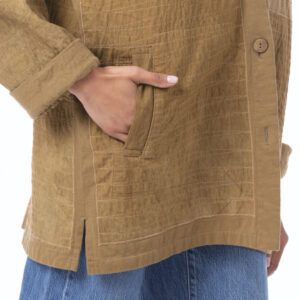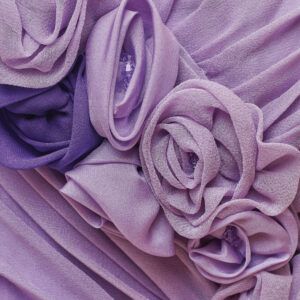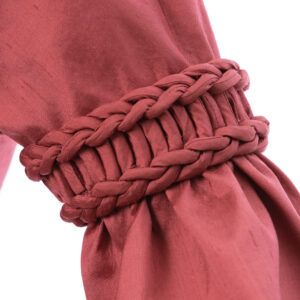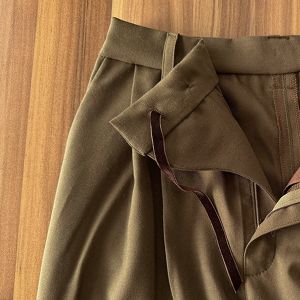Choosing lining for a sleeveless sheath
I found a great-fitting sheath dress and am going to make three copies in a seersucker, a linen, and a gauze. Each needs a lining. I was thinking a medium weight cotton for the first two to add some body and then go nuts and use a silk charmeuse for the cotton gauze.
Can anyone point me to the articles that describe lining sleeveless garments. I’ve seen them, I know I have. And the stack of Threads in my barn–well I’d get lost reading them if I started thumbing through them.
Any particular tips for lining this kind of simple dress? I’ll have a chance of getting it right with three tries!



























Replies
Try a search of this forum; one thread had a lot of useful suggestions for the same question about turning a sleeveless top. If you can't find it, you could also check the instructions from a commercial pattern of a lined sheath dress (you may have one in your stash or may be able to get one for 99c on sale or at a thrift store). Check that the style and shoulder widths are similar to the one you will copy.
Basically, if the sheath has a zipper down the back, you line it and turn it before inserting the zipper or sewing the center back seam; if it's a pullover, you leave the shoulder seams unstitched until you've lined and turned the dress. You also need to use the second strategy if the shoulders are very narrow, as the first method involves pulling the entire body and lining of the dress through the shoulder. (Sounds impossible, but it's not!)
Even experienced sewers get caught in an un-turnable stage on sleeveless dresses--at that point, I carefully pick out a lining seam or two to solve the puzzle and then re-sew them...
I recently visited Tany's blog where she perfectly described the process she used in making a wonderful sleeveless sheath. Tany makes luscious garments using fine techniques I certainly aspire to. Check out her posting from June 4 http://tanysewsandknits.blogspot.com/ just copy and past the address into your browser window and be prepared to be amazed.
Good luck with your project.
Alice
Hi, I like your idea of creating your sheath dress in different fabrics and learning from each attempt. I have to say that I am a big fan of bias binding. Whenever I make a sleeveless blouse or dress that will be lined I complete both the fashion fabric and lining. Working from the bottom or hem line, I turn up and press the hem on the fashion fabric. I shorten the lining fabric at the hemline by 5/8ths then machine sew the lining and shell fabrics right sides facing each other at the hem line. I then pin the hem in place and pin the top of the dress and lining together at the neckline and armholes. I adjust the lining so that it creates a pleat at the hemline creating ease and is shorter than the fashion fabric and won't show from the outside. I press the lining in place. I remove the pins from the neckline and arm holes and allow the lining to drop down far enough to reveal the hemline from the inside. I then hand sew the hem line. I then repin the lining at the neckline and armholes. Sew it together on the 5/8ths seamline and again on the 6/8ths. I trim the fabric on the 5/8ths and apply bias binding sewn from the right side in a narrow 1/8ths seamline by machine. Them handsew from the wrong side to finish. This stabilizes the armhole seam and neckline and looks elegantly finished. I then hand sew the lining fabric to the zipper tape on the inside. I'm always really happy with the way the finished garment looks.
Thank you for this clear description of the way you insert lining into a sheath dress. It sounds beautifully finished. Does your bias binding fold completely to the inside, or does it "wrap around" the 1/8" seam allowance that is left, leaving a 1/8" fold of the binding showing on the outside?
When I use 1/8 bias binding I cut out a 1&1/4 inch piece of bias fabric, either in the fashion fabric or a contrasting fabric. I apply it by folding the leading edge of the bias in a quarter inch or so and sewing one raw edge in a 1/8th seamline continuing until I've sewn over the original leading edge. Then cut the excess away. Before I start to fold the bias over to seal the raw edge I either hand sew or machine stitch the bias fabric to seal the joined area and make the turning and hand sewing easier. When my sewing is complete there is no excess seam allowance or raw edge on the inside. When I hand sew the remaining fabric to the inside I work in small sections folding the remaining raw edge until it meets the raw edge of the garment, then fold again until it lays atop the 1/8th seamline. I hand sew the foldline onto the machine sewn 1/8th seamline. My personal preference for a narrow 1/8th bias finish is usually for silky or delicate fabrics. I think it just looks nicer. A cotton or linen would look very nice with a 1/4 inch bias. You will notice when you are working with bias that you can't just do the math, you have to allow a little extra in the width that you cut out because you have to consider all of the folds. As I work, if I come to an area that isn't staying true to the width of bias that I am trying to achieve, I trim away just enought of the inside raw edge to remove the excess in that particular area or if I need a little extra to accomodate a curve I have it. By hand sewing rather than top stitching the bias finish it honors all of the effort you are putting into your garment. The best kept secret to great sewing is that it takes time and its worth it. I hope this all makes sense and answers your question.
Kudos to you on your excellent explanation for applying bias binding. I also appreciate your secret to fine sewing - takes time because it's worth it - love that!!!
Karen
This post is archived.